((mtr_include))
This week, Gabriel Pacyniak and Katherine Chandler are traveling throughout southern West Virginia to report on mountaintop removal mining (MTR). They’ll be visiting coalfields with abandoned and "reclaimed" MTR mines, and talking with residents, activists, miners, mine company officials, local reporters, and politicians.
We’ll publish their reports throughout the week.
—–
As we wind down our trip, news breaks that the federal Office of Surface Mining has issued new rules that will gut the already weak protections against burying streams during the course of mountaintop removal mining. The change would make it even more difficult, if not impossible, for residents of affected hollows like the Branhams to challenge MTR sites and the accompanying valley fills that threaten their homes.
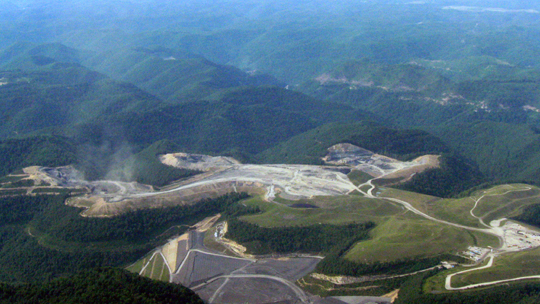
Mountaintop removal site impacting residents below in the valley. (photo: Katherine Chandler)
The rule change will be a substantial setback, but not a surprise, to people like Joe Lovett, executive director of the Appalachian Center for the Economy and the Environment in Lewisburg, W.Va. When we talked to him by phone earlier during the trip, Joe sounded somber. He has been pressing lawsuits against MTR for years, mostly based on the impact of MTR on stream valleys. Although he has won several promising cases, he doesn’t believe anything can change under the Bush administration. "The Bust administration will do whatever it takes to get around any court order that we win," he says. "[They] will just not tell the coal industry, ‘Enough is enough, no more valley fills’."
Vivian Stockman, an organizer with the Ohio Valley Environmental Coalition, calls the situation a "delaying game." "We are going to keep educating people, keep organizing people, but we don’t have high hopes for anything happening under this administration," she says.
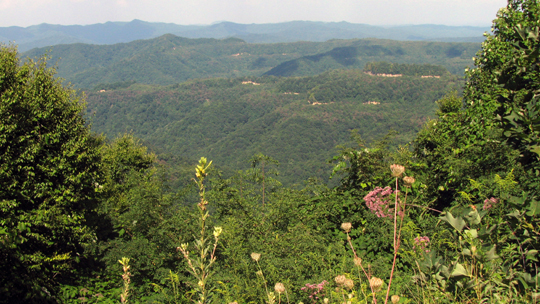
A view of the West Virginia valley without mountaintop removal. (photo: Katherine Chandler)
That’s why she’s also conflicted about the possibility of new federal legislation to amend the Surface Mining Control and Reclamation Act. Rep. Nick Rahall (D-W.Va.), representative of West Virginia coal country and chair of the House Natural Resources Committee, held a hearing on SMCRA on July 25 and is reportedly considering introducing legislation. During the hearing he indicated that he wanted to see more stringent requirements for reclamation but not any substantial restrictions on MTR.
"We are worried that any meaningful legislation would be vetoed by the Bush administration," said Stockman, although she added that some activists are excited by the possibility that other Democrats on the committee will take a more aggressive stance.
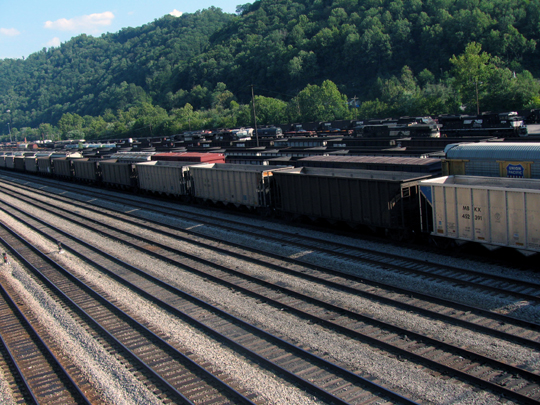
Railroads bringing coal to and from Williamson, W. Va. (photo: Katherine Chandler)
That puts the long-term focus on the next administration, and on the fate of the major energy initiatives currently under debate. Will Congress get behind coal-to-liquid? Will clean coal technology further American dependence on coal? The greater the demand for coal, the more pressure there will be on the next administration to continue or even speed MTR.
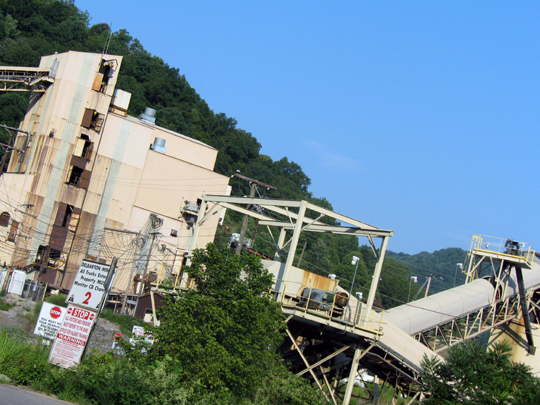
Coal processing plant in the valley of Mingo County. (photo: Katherine Chandler)
In the coalfields, the outlook among critics is determined but sober. Here, opponents of MTR, like Roby and Barbara Chafin, are resolved to prevent strip mining and valley fills as long as they continue to impact their lands. For them, the negatives associated with MTR far outweigh the benefits, even through Roby is yet another a veteran coal miner and they have lived in coal country all their lives. The turning point for Barb was the flooding from MTR that occurred in her hollow in 1989. Currently, she is fighting against another operation near her house, worried that it might cause a similar disaster.
This struggle has not been easy. The Chafins recently won damages in a lawsuit that was filed against them by the land company that leases the land above their house for mining operations. An email that emerged during the trial confirmed that the Chafins were partially targeted because they frequently called to complain about the impact of the mining in their hollow. While they prevailed in the court case, both Barb and Roby maintain that their real battle is to stop MTR in their area.

Devastation of valley fill above the Chafin home in Straight Fork hollow. (photo: Barbara Chafin)
After Barb serves us a spectacular dinner (chicken and dumplings, biscuits, sweet potatoes in brown sugar and almonds), Barb reminds us of why the new ruling by OSM will be so destructive. Recently, she bought a video camera so that she could record the effects of the MTR site above her house on the creek that runs through the hollow. We watch video after video of the creek overflowing, of oily eddies and water that runs like sludge. Barb even brings out two samples of water she keeps in her fridge. The one that came from her tap after a big day of blasting is brown; the one that came out of the creek is black.
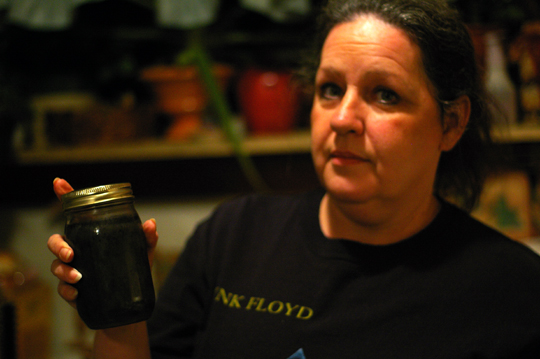
Barb Chafin holds up a water sample she collected from the creek in Straight Fork hollow. (photo: Katherine Chandler)
"Truth is, every hollow in Mingo county is being washed away," she says.


